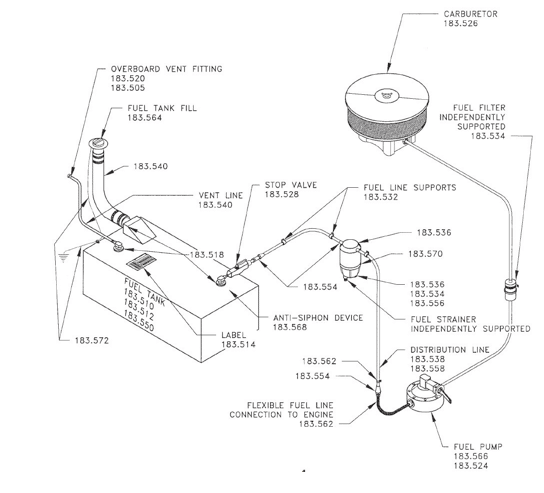
What you don’t know could kill you. D-I-Y individuals without knowledge of the Code of Federal Regulations, Title 33 Part 183 subpart J – Fuel Systems, could be putting themselves and their loved ones in danger due to the explosive nature of gasoline. Even many experienced marine mechanics are not aware of all the Federal regulations relating to fuel systems that ensure your boating safety. The Code of Federal Regulations applies to various types of recreational boats and mainly concern vessels with enclosed gasoline engines such as stern-drives and inboards, including onboard generators.
Gasoline is not only extremely flammable but if ignited in an enclosed space under certain conditions it can violently explode. It is said that a cup of gasoline in a bilge can be as powerful as a quarter stick of dynamite. Because of this danger a boat’s fuel system comes under strict governmental rules. Everything related to the fuel system from the gas tank to the carburetor or EFI including gas line has to meet Federal regulations for fire resistance and durability. Each component has to be fire tested to achieve the performance specifications by organizations such as UL or SAE to be considered for Coast Guard approval on recreational boats. Flame testing is done with the item filled with gasoline and conducted within a fireproof chamber or by direct flame for 2-1/2 minutes. The measured temperature within one inch of the piece has to attain 1200°F (648°C). Upon completion components should not leak significantly or be severely damaged. This explains why fuel filters with clear plastic sight bowls and quick-drains along with other non-metallic fuel system parts are not legal for use in the vicinity of enclosed gasoline engines.
Does Your Boat Comply With Regulations?
Permanent fuel tanks have to additionally meet testing requirements for mounting, sloshing, shock resistance, and pressure. Hose clamps – spring-tension styles are not legal – after the fire test must withstand a 1-pound pull in any direction and not separate, break, crack or deform. Carburetors cannot overflow or be vented to the outside air. Any overflow flooding has to be directed into the engine intake.
To read more about the Federal statutes click on the Code of Federal Regulations for fuel systems. Study the enclosed illustration with the applicable regulation numbers for the individual parts. These legal requirements are for everyone’s protection and safety. Do not substitute automotive or other non-approved parts which could cause injury and damage. Remember that ignorance of the law is no excuse – boat safe!
READ ALL OF OUR ARTICLES ON BOAT ENGINES HERE









